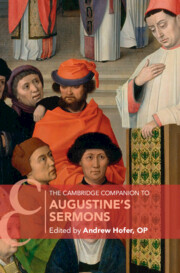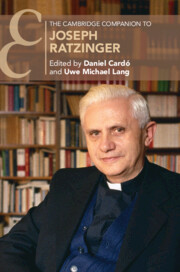Refine search
Actions for selected content:
35 results
17 - Liturgy and the Proclamation of the Word
- from Part IV - Liturgy and the Life of the Churches
-
-
- Book:
- The Cambridge Companion to Christian Liturgy
- Published online:
- 19 September 2025
- Print publication:
- 09 October 2025, pp 299-316
-
- Chapter
- Export citation
16 - Preaching on Heaven and Its Peace
- from Part III - Augustine’s Preaching Themes
-
-
- Book:
- The Cambridge Companion to Augustine's Sermons
- Published online:
- 26 May 2025
- Print publication:
- 12 June 2025, pp 299-316
-
- Chapter
- Export citation
Introduction
-
-
- Book:
- The Cambridge Companion to Augustine's Sermons
- Published online:
- 26 May 2025
- Print publication:
- 12 June 2025, pp 1-22
-
- Chapter
- Export citation
1 - Augustine as Preacher and His Brethren in the Church
- from Part I - Augustine’s Pastoral Task of Preaching Sermons
-
-
- Book:
- The Cambridge Companion to Augustine's Sermons
- Published online:
- 26 May 2025
- Print publication:
- 12 June 2025, pp 25-43
-
- Chapter
- Export citation
12 - Preaching on the Church’s Sacraments
- from Part III - Augustine’s Preaching Themes
-
-
- Book:
- The Cambridge Companion to Augustine's Sermons
- Published online:
- 26 May 2025
- Print publication:
- 12 June 2025, pp 226-244
-
- Chapter
- Export citation

The Cambridge Companion to Augustine's Sermons
-
- Published online:
- 26 May 2025
- Print publication:
- 12 June 2025
Chapter 1 - Passion and Persuasion
-
- Book:
- Protestant Bodies
- Published online:
- 20 February 2025
- Print publication:
- 27 February 2025, pp 38-82
-
- Chapter
- Export citation
Words and the Word: Augustine’s preached theology of language
-
- Journal:
- Scottish Journal of Theology / Volume 78 / Issue 1 / February 2025
- Published online by Cambridge University Press:
- 02 April 2025, pp. 12-23
- Print publication:
- February 2025
-
- Article
- Export citation
Crusade, Politics, and Pastoral Care in the Klosterneuburg Sermons of 1467
-
- Journal:
- Austrian History Yearbook / Volume 56 / May 2025
- Published online by Cambridge University Press:
- 13 January 2025, pp. 13-31
- Print publication:
- May 2025
-
- Article
- Export citation
Politics and preaching: how religious elites justify addressing or avoiding political topics
-
- Journal:
- Politics and Religion / Volume 17 / Issue 4 / December 2024
- Published online by Cambridge University Press:
- 26 December 2024, pp. 627-647
-
- Article
-
- You have access
- Open access
- HTML
- Export citation
2 - Building the Christian Kingdom
-
- Book:
- Conversion and the Contest of Creeds in Early Medieval Christianity
- Published online:
- 06 June 2024
- Print publication:
- 13 June 2024, pp 43-74
-
- Chapter
- Export citation
Chapter 4 - Christianizing Popular Culture
-
- Book:
- Popular Culture and the End of Antiquity in Southern Gaul, c. 400–550
- Published online:
- 15 March 2024
- Print publication:
- 28 March 2024, pp 110-143
-
- Chapter
-
- You have access
- Open access
- HTML
- Export citation

The Cambridge Companion to Joseph Ratzinger
-
- Published online:
- 25 January 2024
- Print publication:
- 21 December 2023
Chapter 3 - Andrewes’ Anti-Puritanism
- from Part I - Laudianism: Where It Came From
-
- Book:
- On Laudianism
- Published online:
- 05 October 2023
- Print publication:
- 19 October 2023, pp 66-79
-
- Chapter
- Export citation
Chapter 7 - The Visible Church and Its Ordinances
- from Part I - Laudianism: Where It Came From
-
- Book:
- On Laudianism
- Published online:
- 05 October 2023
- Print publication:
- 19 October 2023, pp 101-118
-
- Chapter
- Export citation
Chapter 6 - Guitar Lessons at Blackfriars
-
-
- Book:
- Literary Theory and Criticism in the Later Middle Ages
- Published online:
- 20 April 2023
- Print publication:
- 20 April 2023, pp 116-136
-
- Chapter
- Export citation
Chapter 2 - ‘Compassion and mercie draw teares from the godlyfull often’
-
- Book:
- Sympathy in Early Modern Literature and Culture
- Published online:
- 27 April 2023
- Print publication:
- 13 April 2023, pp 72-102
-
- Chapter
- Export citation
Chapter 1 - The Makings of an English Multinational
-
- Book:
- The Dominicans in the British Isles and Beyond
- Published online:
- 02 March 2023
- Print publication:
- 09 March 2023, pp 11-65
-
- Chapter
- Export citation
Chapter 6 - The Remakings of an Observant Province
-
- Book:
- The Dominicans in the British Isles and Beyond
- Published online:
- 02 March 2023
- Print publication:
- 09 March 2023, pp 224-272
-
- Chapter
- Export citation

The Dominicans in the British Isles and Beyond
- A New History of the English Province of the Friars Preachers
-
- Published online:
- 02 March 2023
- Print publication:
- 09 March 2023
